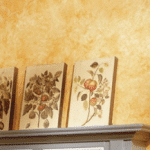Choosing Colors for House Painting
A home interior project involves hundreds of big and small decisions and the most important of them all is choosing right paint color for interior walls. We often finalize a paint color and then face the fear if it does not look as good as you expected once it has been applied to the wall. This is a sheer waste of time and money. Among thousands of combinations choosing one final shade is intimidating, but by having basic understanding of colors, you can easily create a scheme you love.
Colors and Their Effects
Before finalizing a color consider the effect it will create in the room. To understand various colors and how they affect mood let’s divide them into four main categories.
- Warm and Cozy Colors – Red, orange and yellow are considered to be warm colors. These colors convey a message of togetherness and strength. Red represents energy and is a common choice of dining room. Orange creates sense of joy and is often used as only an accent color. Yellow is a happy color but its effects depend on how much it is used.
- Cool and Soothing Colors – Green, blue and violet are soothing colors that provide a sense of trust and calm. Green conveys growth and renewal and blends easily with any wall. Blue is a color of peace and a light blue shade makes a room appear light and refreshing. Violet is often used in bedrooms to spread serenity around.
- Pastel Colors – Add a large amount of white to any color and a pastel color is ready. For a comfortable and airy feeling you can use pastel shades in any room.
- Neutral Colors – White, beige, gray, black, taupe; they all are neutral colors you can use to paint your interior walls. The best thing about the neutral colors is that they blend easily with most surroundings. Neutral colors can also be very dramatic and stylish when used with additional colors.
What are Color Schemes?
A color scheme is a set of colors that look appealing together. Common color schemes are created using complimentary colors, related colors or monochromatic colors (colors with the same hue but different tones) but possible combinations can go to any length.
Working with the Color Scheme
When you are ready with your color scheme one final exercise you need to do is to use three different values: light, medium and dark. Use lighter shades on walls and floors. Keep the wall colors lighter than the floors to prevent a floating effect. Large pieces of furniture and window coverings are typically done in medium value to pull the effect of light floors and walls together. The darkest color from your color scheme should be used as an accent color sprinkled throughout the room.
Choosing the right color will go a long way in you and your family having a feeling of wellbeing and will uplift your mood.





